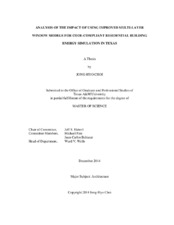| dc.description.abstract | In most urban areas of United States, newly constructed buildings have to comply with building codes from the International Code Council (ICC) or from the American Society of Heating, Refrigerating and Air Conditioning Engineers (ASHRAE). Windows are a crucial building component that affects a building’s heating and cooling energy. Currently, there are two window modeling methods, the Transmittance, Absorptance and Reflectance (TAR) method, and the Multi-Layer Window (MLW) method. MLW method is more accurate than the TAR method, because it includes improved equations that better represent the actual window properties. However, at present both building codes (i.e., ICC or ASHRAE) do not use the MLW method to model the windows in a building. Therefore, there is a need to analyze annual building energy simulation results differences between the two different window modeling methods applied building model, in order for code officials to better determine the impact of the code change.
This study analyzed both window modeling methods with the International Energy Conservation Code (IECC) 2009 and the IECC 2012 conditions for climate zones in Texas. The results show that there are significant differences in annual building energy end-use, heating and cooling energy use, and peak heating and cooling loads for identical code-compliant houses using the two different window models. In addition, such differences become larger as the building energy code improves, from the IECC 2009 to the IECC 2012. Suggestions for future work are also included for other climate zones, different building footprints, and other various building operating schedules. | en |


